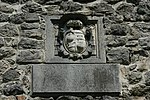Plainburg
| Plainburg | ||
|---|---|---|
|
The Plainburg seen from the south |
||
| Alternative name (s): | Salzbüchsl, Plagien Castrum | |
| Creation time : | 11th century | |
| Castle type : | Hilltop castle | |
| Conservation status: | ruin | |
| Place: | Grossgmain | |
| Geographical location | 47 ° 43 '31.8 " N , 12 ° 55' 16.8" E | |
|
|
||
The Plainburg , also known as Salzbüchsl , in Großgmain in the state of Salzburg is one of the oldest castle ruins in Austria .
location
The ruins of the Höhenburg are located about 1.5 km (road) from the center of Großgmain. It lies at an altitude of up to 643 m above sea level. A. , above the Gmainer valley (with a view of Großgmain and Bayerisch Gmain ).
history
The mountain was already in use around 1200 BC. BC as a burial place for the Celts.
It is assumed that a Roman fort was located at the site of the current ruin while the area was part of the Roman Empire.
In 1108, Comes Werigandus de Playen , who built at least the inner courtyard and the gatehouse around 1100, is named as the builder in an imperial deed. The Plainburg was first mentioned in a document around 1140 as Plagien Castrum and from then on served the Plainers until the sinking of the Plainers (deaths of Otto II and Konrad III in 1260). It is not clear whether the current walls around the outer courtyard were built by the Plainers themselves or later, but it is certain that these walls have a different, somewhat sloppy construction - the current degree of preservation is much worse. In 1292 the castle passed into the possession of the Archbishopric of Salzburg and then served the Prince Archbishops of Salzburg as a state fortress and a place of defense for the salt trade routes between the Bad Reichenhaller Hallgrafen and Salzburg . In the period between 1470 and 1800, significant structural changes (mainly of a military nature) were made to the castle. In 1620 the castle complex was restored by Archbishop Paris von Lodron . In 1674, the gate between the inner and outer courtyard was given its current Gothic appearance, the coat of arms - which is placed over this gate - comes from Archbishop Max Gandolf Freiherr von Kuenburg .
In 1796 the last soldier left the fortress; The collapse that was initiated could not be stopped by either King Ludwig I or Prince Otto von Bismarck .
The only tactically unfavorable part of the castle is the east side with the gatehouse. However, this shortcoming was compensated for by a cleverly laid out path that runs steeply towards the gatehouse in two long curves - the last part being laid out in such a way that an attacker always has to turn his right side (usually unprotected by the shield) towards the castle.
In the 1970s, during structural security work on the gatehouse, the top floor was removed, and the walled-in skeleton of a child was discovered. The skeleton find overlaps with an old tradition (admittedly, this legend does not necessarily have to be related to the child who was actually walled in, building sacrifices were not uncommon in the Middle Ages and early modern times): The legend tells of an early Plain count who had a child was robbed. When he was invited by Wetzel von Glanegg , he was finally presented with a dead child for a feast - the count recognized it as his own and had it walled up in the Plainburg.
The facility is now a listed building .
investment
Only the five-meter-high and an average of 1.45-meter-thick outer walls, the inner courtyard and the entrance area with gatehouse are all that remains of the Plainburg.
Today the castle ruin with a viewing platform and a wide view is a popular destination. The ruin is accessible all year round between 9 a.m. and 7 p.m., but the inner courtyard is closed in winter. Entry is free.
literature
- Ruin Plain. In: Kunsthistorisches Institut der k. k. Central Commission for Monument Preservation (Ed.), Max Dvořák (Red.): Austrian Art Topography. Volume 11: Paul Buberl, Franz Martin (archival part): The monuments of the political district of Salzburg. III. Part: Salzburg judicial district. (The monuments of the judicial district of Salzburg). Schroll, Vienna 1916, pp. 152–155 (PDF) .
- Johannes Lang , Max Schneider: On the Gmain - Chronicle of the communities Bairisch Gmain and Großgmain. With a contribution by Fritz Eberlein. 1st edition (1995) Self-published by the municipalities of Großgmain and Bairisch Gmain (on Plainburg see above all pages 45 to 53).
- Johannes Lang: Reichenhaller Burgenweg Verein für Heimatkunde, Bad Reichenhall 2004, p. 30f
Web links
- Entry via Plainburg to Burgen-Austria
- Plainburg on the site burgseite.com
- Plainburg on ruins empire
Individual evidence
- ^ "Plainburg" at www.burgen-austria.com, accessed on December 27, 2017.
- ↑ As of July 23, 2012










